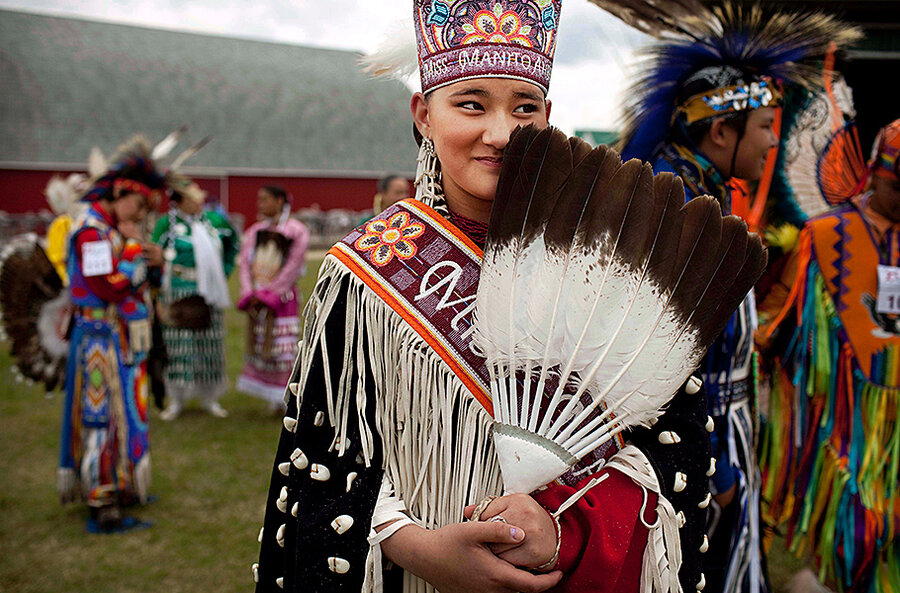Canada's most racist city? A year later, Winnipeg takes stock
Loading...
| WINNIPEG, Canada
Last year, Winnipeg got slapped with a moniker it most definitely did not want: Canada’s most racist city.
According to the influential Maclean’s magazine, the “Chicago of the North” badly neglected and abused its aboriginal population, who were constantly on the receiving end not only of slurs and taunts but also of poor policing and appallingly inferior public services.
The biting take on the city – which has prided itself on welcoming newcomers from Europe, Asia, and elsewhere – deeply wounded Winnipeg’s leaders, who quickly vowed publicly, even tearfully, to do better.
A year on, the city of 700,000, continues to grapple with deep problems. It is the capital of the western prairie province of Manitoba, where the high school graduation rate for aboriginal students is less than half of that for white ones, and 90 percent of the some 10,000 children in state care are aboriginal.
But many say that the dynamic has in fact changed for the better. Not only did a debate that was already under way gather new energy, but it is happening as freshly elected Prime Minister Justin Trudeau prioritizes aboriginal issues after years of neglect.
“I think [the article] brought a light to important issues involving Winnipeg, and those of us on the ground working every day have found that there is more amicability and openness since that article. For the non-indigenous community, the article was a shock and opened up ears and eyes,” says Niigan Sinclair, acting head of the Department of Native Studies at the University of Manitoba.
An examination of recent history provides many turning points.
Within weeks of his election, Mr. Trudeau launched an inquiry into the 1,200 aboriginal girls and women murdered or missing since the 1980s, a phenomenon dismissed as a "crime and not a social phenomenon" by defeated Prime Minister Stephen Harper.
In mid-2015, the Truth and Reconciliation Commission of Canada published its report. Led by Murray Sinclair, an aboriginal judge who was appointed to the Provincial Court of Manitoba in 1988, it underscored the enduring effects of more than a century of "residential schools" – which seized aboriginal children from their parents for the purpose of "taking the Indian out of the child." The last one closed in 1996, and Sinclair says his best guess is that 6,000 children died in them.
But for many, the key event changing public perception was the August 2014 murder of 14-year-old Tina Fontaine, whose body was dumped in the Red River. The violent demise of a girl who had gone missing after making her way to Winnipeg from a First Nations reserve sparked an outpouring of grief, with aboriginals and non-aboriginals linking arms in a thousands-strong vigil.
Sheila North-Wilson, grand chief of the Manitoba Keewatinowi Okimakanak organization representing northern First Nations reserves, said the murder was a turning point. "I think people are talking about it more and more openly now,” she says. “And they're standing up more for themselves and others now.”
But, she adds, little on the ground has changed. Last month, she made headlines with an account of being tracked by security staff as she shopped in a pharmacy.
"I've lived in other cities and the only times I have ever come up against bald racism is here in Winnipeg," she says. “It is taking a while for society to accept that this is a problem that has to be changed."
While most observers found the allegations of entrenched racist behavior and inadequate services justified, even some aboriginals found the designation of the "most racist city" somewhat arbitrary and sensationalist.
"Is there a race problem in Winnipeg? Absolutely, yes. Is Winnipeg the most racist city in the country? That's the most absurd thing I've ever heard in my life," says Dr. Sinclair of the University of Manitoba.
For Robert-Falcon Ouellette, one of a record 10 indigenous candidates elected to parliament in October, the discussion may also cause problems – masking the poverty that grips the North End, once the starting point of Winnipeg's sizable east European immigrant community, as well as his city center constituency, the second poorest in the country.
"Did the city change? Well, we're talking now," he said. "But look around the city. Look at how poor people are. For me, sometimes people fundamentally don't understand what the actual question should be. It's not about racism. I think it's lack of economic opportunities for too many people for too long."
Mayor Brian Bowman, the first to hold the office with Métis ancestry – mixed parentage from the European and aboriginal communities – has hosted high-profile events, including a "racism summit" last September, denounced by detractors as preaching to the converted and boycotted by some activists over a $50 (Canadian; US$35) admission fee.
To mark the first anniversary of the article's publication, Bowman convened a new gathering dubbed "a year of reconciliation," but things went badly off script. A woman of Somali origin interrupted proceedings to complain that social services had taken away her children. Some aboriginal elders, including Grand Chief North-Wilson, left in protest at the guest list and protocol issues.
But for some jolted by the magazine's allegations, like City Councillor Mike Pagtakhan, the mayor is doing the right thing.
Pagtakhan, a member of the 70,000-strong Filipino community, Manitoba's largest immigrant group, said some accounts by aboriginal children at seminars reminded him of the taunts directed at him at age seven for being "Chinese."
"I think [Bowman] is on the right path. He is not shying away from the fact that racism exists in our city," he said. "We have sort of created a brand for Winnipeg in terms of a city that is talking and can reconcile some of the hard issues it has to deal with."





